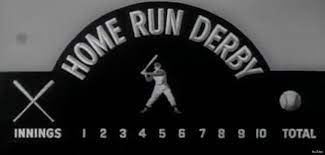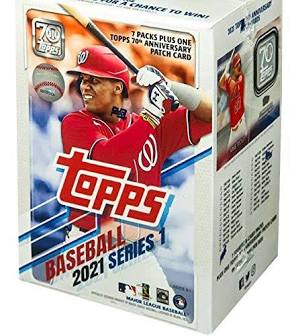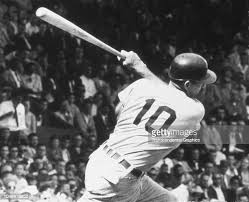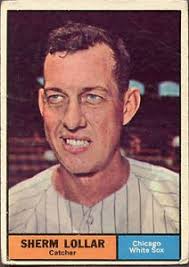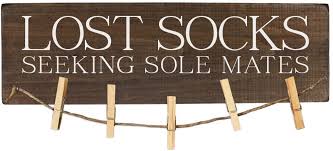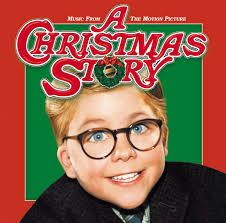Fellow I.U. grad, Kyle Schwarber, hit a monster home run yesterday to assist in a Game 1 Phillies NLCS victory. It sparked memories of the Cubs World Series run six years ago where he and Anthony Rizzo, now a Yankee, made history. “Riz” also hit a bomb off of Verlander last night in a losing cause in his quest for another World Series ring. “Schwarbs” has made several appearances in the All Star Game Home Run Derby, slugging 55 home runs. Rizzo and Kris Bryant both participated in 2016, the first Cubs since Sammy Sosa’s 4th attempt in 2004. The only modern day Derby that I witnessed live was Miami 2017 with Aaron Judge winning it all. I ran across an interesting article written by Arnold Bailey about the early days of the 1960 TV show. It was a great childhood memory for me, recreating the event in our back yard with a whiffle ball and bat.
From a baseball card collecting perspective, “a set of 20 baseball cards was produced picturing the collection of sluggers the show would feature. Today, those cards have gained a cult-like following and are among the hobby’s scarcest. American Motors, the show’s sponsor, produced the cards which were handed out at the carmakers’ dealerships across the country. Created in 1954, American Motors was then No. 4 behind the nation’s Big 3 (General Motors, Ford and Chrysler), with Rambler its top car. Apparently, neither AMC’s cars or its cards were overwhelmingly popular. That may be one reason why the “Home Run Derby” cards are so scarce today.” I was certainly not aware of them.
“The cards are about postcard size (3 1/8”-by-5 1/4”) and are unnumbered with blank backs. The fronts feature black-and-white posed photos, most of which show players from about waist up. The pictured player’s name and team are in two lines across the bottom. A black circle that promotes the show with a ‘See Home Run Derby on TV!'”
“The 19 players include nine future Hall of Famers (Hank Aaron, Ernie Banks, Al Kaline, Harmon Killebrew, Mickey Mantle, Eddie Mathews, Willie Mays, Frank Robinson and Duke Snider) plus 10 other sluggers of that era. All but three of the players are pictured holding a bat, either resting it on a shoulder or positioned at the start of a swing. The other three – Bob Allison, Jackie Jensen and Eddie Mathews – are attempting to hold a smile while posing for the camera.”
“Fifteen of the 16 teams that then comprised Major League Baseball were represented on the show and the cards. Only the Chicago White Sox aren’t included, although the Pale Hose won the American League pennant in 1959. But the team hit few home runs despite its winning season (the team’s homer leader was catcher Sherm Lollar with just 22). While the pennant-winning White Sox have no representative in the “Home Run Derby” lineup, the lowly Washington Senators (who finished in last place, 31 games behind Chicago) have three (Killebrew, Bob Allison and Jim Lemon).”
“The other dozen teams sent one player each to hit homers: Banks (Cubs), Ken Boyer (Cardinals), Bob Cerv (Kansas City), Rocky Colavito (Indians), Jackie Jensen (Red Sox), Kaline (Tigers), Wally Post (Phillies), Dick Stuart (Pirates) and Gus Triandos (Orioles).”
“The home run totals for the 19 players would eventually reach 7,375 by the end of their careers. So the home run lineup was a powerful group, including three of the Top 10 homer hitters of all time (Aaron, 755; Mays, 680; and Frank Robinson, 586).
The 20th card (now the hardest to find) in the set pictures Mark Scott, the play-by-play broadcaster of the original TV show and one of the creators. Here’s a link to the article with even more interesting details:
We’re experiencing very bad internet service in Skagway. I can see where the Colts and Bears both won today but can’t get any details. The same is true with my E-Bay auction that ends today for the Sherm Lollar Lanes match book -pretty sure I’ll get sniped at the last minute but it’s not worth more than the $20 bid I made. It ultimately went for $20.50 as I feared.
We spent the morning in a fog, missing most of the sights along the White Pass Summit Vintage Railroad tour. It was amazing to see how this route was built through rock and over fjords to establish a goods exchange between the city of Skagway and its Canadian neighbors. It runs along the narrow rocky trail that prospectors used during the Klondike Gold Rush of 1899. I was concerned that the Canadian Mounted police might board the train as we circled back just over the boarder, demanding my surrender for not taking the mandatory covid test that I was randomly selected to undergo (See Post # 2147). Once the threat never materialized, my wife counted over 60 waterfalls along the way back until she lost interest and began to focus on downtown shopping.
I had a Alaskan beer yesterday afternoon at Juneau’s Red Dog Saloon complete with swinging doors and sawdust floors. It was my first beer since our Portland Leadership Meeting at Two Dogs Tavern – a dog theme is apparently forming when it comes to bars. Three Dog Night is probably next or the Dog Sled Saloon. I’ve mostly stuck to premium red wines or Chef’s Table pairings, Champagne, Limoncello, and Cranberry juice/Tito’s Vodka spritzers on the cruise.
As we crossed the treacherous bridges and trestles along the way, my wife was feeling squeamish and wondering why I was’t? Well, she had me all psyched for yesterday’s Brotherhood Bridge that turned out to be just street level, plus heights don’t seem to bother me in an enclosed area like the train car. It was built to celebrate the joining of the Huna Tlingit eagle and raven clans through marriage, as it is unacceptable to marry a fellow clan member. We learned all about Alaskan tribal clan houses, Potlatch parties/hats, and totem pole lore in Ketchikan.
It made me think of all the bridges we’ve crossed just in the past few months. These include Alabama’s Selma Bridge, Michigan’s Mackinac, Florida’s Skyway, Hope Memorial in Cleveland with the Guardians, the L&I over the Ohio River linking Indiana and Kentucky, the Venice Island drawbridge in our hometown, and the many bridges that span the canals in our Islandwalk neighborhood. Tomorrow, we’ll spend some time exploring Glacier Bay where the only bridges are made of ice.
I added the 1956 Chicago White Sox Topps team card to my collection this week. I have an autographed baseball from that year and the same team photo clipped from a 1955 magazine. Sherm Lollar is in the back row next to Nellie Fox. The White Sox of 67-years later continue to underachieve with another lackluster home loss last night following the All Star break. Tim Anderson and Liam Hendriks were the Sox 2022 representatives as the American League won for the ninth straight time. The Pale Hose had finally gotten to the .500 mark on the season and within three games of first place Twins in the division before losing 8-2 to the second place Guardians. Now, the gap is 3.5 games going into today’s double header at Guaranteed Rate Stadium.
I have given up on the White Sox many times already this year. It’s frustrating to watch them fall behind early in games, leave so many potential runs on base, and make sloppy errors in an effort to catch up. Yosmani Grandal came back from the injured list to go a pitiful 0-3 in clutch situations. Luis Robert took his place on the DL with dizzy spells. Injuries and a lack of hustle have sadly become their trademark this season.
I was only 5-years old when the 1956 Sox took the field. Sherm Lollar hit .293 and had 11 home runs and 75 RBIs. It wasn’t until 1959 and the televised World Series games that he became my favorite player. Minnie Minoso led the 1956 team with a .316 batting average. Larry Doby was the home run leader with 24 on this team that finished 3rd in the American League with a record of 85-69. As far as the All Star game, Yogi Berra (2-2) of the Yankees won the starting position as catcher with Sherm (1-2) as his back-up. The NL won 7-3. I might have been a Mickey Mantle fan back then, but soon fell for #10 Sherman Lollar and have been following him ever since.
Let the Games Begin! The Playoffs are finally underway, while the Cubs have been put out of their misery. It’s hard to believe the late season success of the Cardinals or the fact that it could all for them end in one Wildcard game. My focus is now primarily on the SOX and their 76-year old manager, Tony La Russa. It’s been 16-years since they last won the World Series, but only 10-years for him in the same role with St. Louis. The White Sox lost two out of three to the A’s in last year’s Playoffs while La Russa was still enjoying retirement. Let’s hope for a deeper run in 2021.
I’m starting today in Tampa after four days in Pittsburgh. It’s a Sunday, but I actually wrote this yesterday on the plane, knowing that I would be crunched for time. I will be trading my family for my wife’s over the next three days as we make our way back to Venice. I’m glad the Braves made the Playoffs since we’ve moved into their Spring Training neighborhood. There will be some watch parties at the Stadium near our home, a great way to start a relationship with my new team. Maybe they’ll even have an afternoon game that I can stay awake to watch. Former baseball home favorites have included Chicago, St. Louis, Texas, and Seattle on our moves across the country over the past 25-years. However, the SOX will always be my favorite thanks to Sherm Lollar and the 1959 crew that become my first childhood baseball love.
It took 54-years of my lifetime for the White Sox to win a World Series and 65-years for the Cubs to claim a crown, although they were primarily my dad’s and son’s favorite. My dad originally tried to coax me into being a Detroit Tiger’s fan, that would have been even more frustrating. He did pry my allegiance away from Mickey Mantle like every other kid my age back then, but I chose the White Sox because he insisted that I support someone closer to home. If I hadn’t followed his advice, I could have been an obnoxious Yankees fan.
The Damn Yanks are slipping in the Playoff race, but the SOX are solidly in the field. The Cubs are on the outside looking in, while my dad sadly died before his Chicago team finally won it all in 2016. I’m ready for some Playoff baseball where the SOX will finally face some competition. They’ve been playing most of this injury plagued season with a firm grip on the AL Central. If they can stay healthy, they have a strong chance of winning it all. If they can’t do it, maybe the Braves can, so Let The Games begin.
The last few days I’ve taken a step back sixty years, sitting on my floor sorting baseball cards. I had some unopened packs from 1991 and 1992 to open, including The Babe Ruth Collection. There was a time when I would have left them in their wrappers, hoping they would have more value, but why deny myself the joy of opening them and organizing them into teams. In this case, there was no bubblegum involved. It was fun, until I realized that I was just one card short of completing the Babe Ruth set of 165. Card number 134 was missing, but the next day I found it stuck to another card, just before I was ready to order it on E-Bay. All the Cubs and White Sox players are placed in a special binder while all the others are lumped together in separate books. I can’t bear to throw any of them away regardless of duplicates, knowing that my entire childhood collection disappeared due to good housekeeping.
I’m certain that my now valuable Mickey Mantles were part of that loss, but if everyone had held on to their cards they all would be worthless. #7 Mickey was once my favorite player and his Yankees my team, but they were somehow replaced with #10 Sherm Lollar of the White Sox. I now have a massive collection of Sherm stuff that is only valuable to me. Mickey has made many men rich by simply investing in his memorabilia, or being lucky enough that their mom didn’t toss out their card collections. Right now, I’m even bidding for a Cancer Foundation medallion with the likeness of Sherm on one side and teammate Nellie Fox on the other. Hall of Famers like Fox drive up the value and increase bidding, which makes me think that I will probably not be the winner of this trinket. They both died at young ages due to cancer. The cheek-full of tobacco that became the shortstop’s trademark look probably didn’t help. Most ballplayers were smokers in that era, with little to do in the confines of the dugout.
There is an organization founded by Marv Samuel, a pitcher for the St. Louis Browns in the late 40s and perhaps a Lollar teammate, known as Chicago Baseball Cancer Charities. It is “a 501(c)(3) nonprofit using sports to give back by helping fund cancer research and patient care programs at Chicago-area hospitals, and supporting services to empower kids with cancer.” Billy Pierce, White Sox pitcher and teammate of Fox and Lollar, led the organization after the death of Samuel in 1993 from Leukemia. “Chicago Baseball Cancer Charities has since its founding in 1971 donated more than $11 million to fund cancer patient care, education and research programs at Chicago’s Northwestern Memorial Hospital and Children’s Memorial Hospital.” I’m assuming that the medallion was part of the fundraising elements of this organization.
I just ran across a Billy Pierce baseball card last night. He lived to be 88 and was on two World Series runners-up teams, the 1959 White Sox and 1962 San Francisco Giants. It’s amazing what you learn about the good that players do during and after their time in baseball, although Lollar died at age 53 and Fox even younger at 47, so they did not get the opportunity to give as much back. Every card and piece of memorabilia has a story. Collecting is more than just child’s play – it’s part of our history that I enjoy!
I drove to Tampa with my son to watch the White Sox play the Rays yesterday afternoon. Along the way, I reunited with a fellow Sox fan, who last went to a game with me at then named Verizon Wireless Stadium fourteen years ago. We hadn’t seen each other since. The Cubs beat the Sox that May day in 2007 11-6 and proceeded to be blown out by the Rays 9-0 in yesterday’s encore. I’m suddenly not sure if we’ve ever seen them win together, but we’ll probably keep trying now that we only live an hour apart.
In 1962-1965 the White Sox were the home town Florida favorites, known as the Sarasota Sox, long before the Rays and Marlins became the Sunshine teams to support. White Sox Spring Training has moved to the West Coast and the Cactus League, so it’s mostly old timers like me that are White Sox fans in this area. My love of the White Sox began in 1959 with a catcher named Sherm Lollar. I was 8 years old when the Sox played the Dodgers in the televised World Series and #10 became my favorite jersey number. I wore it yesterday in honor of Sherm, even though it has belonged to a worthy Yoan Moncada for the last five years, as well as Pete Appleton in 1940 and Red Wilson 1952 before Sherm joined the team. Lollar has worn it the longest, eleven years, from 1953-1963. Since that time, it’s changed hands many times, including J.C. Martin (2), Tommy Davis, Chuck Brinkman (2), Jay Johnstone (2), Sam Ewine, Ron Santo, Jack Brohamer (2), Ron Blomberg, Joe Gates, Steve Lyons, Fred Manrique (2), Shawn Jeter, Mike LaValliere (3), Dave Steib, Darren Lewis (2), Chris Snopek, Mark Johnson (2), Royce Clayton (2), Shingo Takatsu (2), Bob Makowiak (2), Alexei Ramirez (8), and Austin Jackson. I proudly display in my personal collection, Sherm Lollar’s 1955 game worn jersey #10.
The number 10 should have probably been retired by the White Sox, along with Nellie Fox #2, Harold Baines #3, Luke Appling #4, Minnie Minoso #9, Luis Aparicio #11, Paul Konerko #14, Ted Lyons #16, Billy Pierce #19, Frank Thomas #35, Mark Buehrle #56, and Carlton Fisk #72. The White Sox once had a team Hall of Fame but put it in mothballs in favor of an expanded gift shop. He is a member of the Chicago White Sox All-Century Team. At this point, he’s probably too far down the Cooperstown list to ever be included, despite his stellar 18-year .992 fielding percentage. However, I continue to collect his memorabilia, the latest being a vintage 1959 Rawlings baseball bearing his likeness that is still in the box.
In an article written by Brett Kiser twelve years ago, he mentioned that the great Ted Williams claimed the Pale Hose never would have made it to the 1959 World Series without Lollar. Kiser also pointed to his three Gold Glove Awards and the fact that he was named to seven All-Star squads (playing in nine games). Despite the loss to the Dodgers in 1959, he earned two World Series rings as a player with the Yankees 1947 and as a bullpen coach for the Baltimore Orioles 1966. I have made my case for his Hall of Fame induction. (See Post #5)
I honor Sherm Lollar today on what would have been his 97th birthday. He died in 1977 at the age of 53. Although I never met the man, I somehow feel compelled to collect articles, press photos, cards, merchandise, and gear related to his career. He lives on in my office, along with his Hall of Fame teammates that certainly believed that he belonged beside them in the Hall, as the field general in their 1959 title quest. I was disappointed with the effort of yesterday’s White Sox in Tampa and noted that the 2005 World Series patch on my #10 jersey was now 16-years old. As a lifelong Sox fan, it’s been too long of a wait again for that elusive title.
I’ve added several magazine clippings to my personal Lollar collection over the past month. These are mostly photo panels from True, a men’s publication in operation from 1937 until 1974. To additionally honor Sherm, I found this excellent article on-line by John McMurray that summed-up his career. It’s based on Lollar’s biography that was included in the book “Bridging Two Dynasties: The 1947 New York Yankees”(University of Nebraska Press, 2013), edited by Lyle Spatz. An earlier version originally appeared in SABR’s “Go-Go To Glory: The 1959 Chicago White Sox” (ACTA, 2009), edited by Don Zminda.
Soft spoken and self-effacing, Sherman Lollar provided a strong defensive presence behind the plate during his eighteen-year Major League career. Lollar spent twelve seasons with the Chicago White Sox, after spending all or parts of six seasons with three other American League teams. An All-Star catcher seven times, Lollar won American League Gold Glove awards from 1957 through 1959, the first three years it was given.
Though Lollar played well and received awards during the 1950s, he did not receive as much national recognition as did fellow catcher Yogi Berra, who won three Most Valuable Player awards. As Red Gleason wrote in The Saturday Evening Post in 1957, “It is the fate of some illustrious men to spend a career in the shadow of a contemporary. Adlai Stevenson had his Dwight Eisenhower. Lou Gehrig had his Babe Ruth. Bob Hope had his Bing Crosby. And Sherman Lollar has his Yogi Berra.”
John Sherman Lollar, Jr. was born on August 23, 1924, in Durham, Arkansas, to John and Ruby (Springfield) Lollar. When Lollar Jr. was three years old, he moved with his family to Fayetteville, Arkansas, where his parents opened a grocery store. Lollar’s interest in baseball began at an early age, and he remembered playing catch with his father outside the store as a six year old. When he was eight, his father died unexpectedly during surgery. At that early age, Lollar, who was the oldest of four children, including two girls (Bonnie and Pat) and a boy (Jerry, who was born after his father’s death), had to take on additional responsibilities at home. His mother sold the grocery store and began working in a nursing home for the Veterans Administration. She told Gleason, “Sherman took a large share of the responsibility of looking after the younger children. He was both a big brother and father. Our being left alone so soon created a sense of oneness in all of us that remains even now.”
Despite his additional responsibilities, Lollar’s interest in baseball never waned. In 1936, shortly before he turned twelve, Lollar became a batboy for the Fayetteville Bears in the Arkansas-Missouri League. After graduating from Fayetteville High School, a school that had no baseball team, the sixteen-year-old Lollar took a job with J.C. Penney in Pittsburg, Kansas. He played with a team affiliated with the Chamber of Commerce in the Ban Johnson League while also studying at Pittsburg State Teachers College (now Pittsburgh State University). Two years later, after the Ban Johnson League folded, Lollar both played for and managed the semipro Baxter Springs (Kansas) Miners, working as a brakeman in a local mine when he wasn’t playing baseball.
The Baltimore Orioles of the International League signed Lollar in 1943, when he was eighteen. His pay was $20 a month. He batted just .118 in twelve games, but improved to .250 with fifteen home runs in 1944. He also drove in seventy-two runs, one of the highest totals for any catcher in organized baseball that year. Lollar won the International League’s Most Valuable Player award in 1945, tearing up the league with thirty-four home runs, 111 runs batted in, and a league-leading batting average of .364.
Baltimore had a working agreement with the Cleveland Indians and was forced to sell its top slugger to the Major League team for $10,000. After making his big league debut on April 20, 1946, Lollar played infrequently behind veteran catchers Frankie Hayes and Jim Hegan. He asked to go back to Baltimore so he could play regularly. Back in the International League, Lollar was unable to duplicate his previous year’s batting success. He batted just .234, but he did hit twenty home runs in only 222 at-bats for the Orioles. His biggest plus that year was meeting his future wife, Connie Mattard, whom he married in 1949.In December 1946, Cleveland included Lollar in a five-player deal with the New York Yankees. The Indians had been willing to trade Lollar because of concerns about his attitude. According to writer Bill Roeder, “The Cleveland complaint was that Lollar displayed insufficient dash and spirit. He had the ability all right, but no inclination to exploit it. Within a month, he was homesick for Baltimore, and Cleveland manager Lou Boudreau sent him back. Now Sherman belongs to the Yankees, and they hope he will react favorably to the fresh start.”
In New York he was caught in a catching logjam that included Ralph Houk, Charlie Silvera, Aaron Robinson, Gus Niarhos, and Yogi Berra. As a consequence, Lollar spent most of the 1947 season with the Newark Bears, the Yankees’ farm club in the International League. Lollar appeared in only eleven regular-season games for the Yankees in 1947, but he did play in the World Series against the Brooklyn Dodgers, getting three hits, including two doubles, in four at-bats. About Game Three, sportswriter Dan Daniel wrote, “A secondary standout was Sherman Lollar, who started the game as a surprise entry. Manager Bucky Harris benched Berra in favor of the right-handed Lollar against the southpaw Joe Hatten. Lollar got a single which became a run in the third, and in the fourth drove in a run with a double.”
A contemporaneous article called Lollar “a Charlie Gehringer type,” adding, “He appears a colorless, dispassionate individual, on and off the field, but he gets his job done effectively. If Lollar hits as well as Gehringer did, no one will care if he doesn’t say a word all season.” In parts of two seasons with the Yankees, Lollar saw action in only thirty-three games. Yogi Berra was on his way to becoming a star and Lollar’s playing time was further reduced by a hand injury caused by a foul tip, requiring him to get stitches on two fingers of his throwing hand.
In August 1948, Dan Daniel wrote, “Sherman Lollar, right-handed hitting catcher, is another who has possibly had his last big opportunity with the Bombers. Now that Yogi Berra is available again, Gus Niarhos will handle all the receiving duties against left-handed pitching.” Not surprisingly, Lollar was soon traded, this time to the St. Louis Browns on December 13, 1948, with pitchers Red Embree and Dick Starr and $100,000 in return for catcher Roy Partee and pitcher Fred Sanford. In St. Louis, Lollar took over for Les Moss as the team’s regular catcher and batted .261 in 1949 with eight home runs. For three seasons, Lollar stabilized the catching position for the second-division Browns while earning All-Star honors for the first time in 1950.
After the 1951 season, the Chicago White Sox were looking for a replacement for incumbent catcher Phil Masi, and on November 27, they received Lollar from the Browns in an eight-player deal. According to his son, Lollar’s salary was increased to about $12,000 when he was traded. Arriving in Chicago was the break Sherm Lollar needed. Unlike the Browns, who had won only 52 games in 1951, the White Sox had finished eight games over .500 and were considered a potential World Series contender. But the 1952 season was a disappointment for Lollar, who endured additional stress when his wife fell ill after childbirth. While he batted only .240, his work with manager Paul Richards helped turn the young catcher’s career around.
As Gleason recounted in The Saturday Evening Post, Lollar later said: “When I was having that terrible year in 1952, Richards called me into his office late in the season. He told me that my natural style of catching lacked appeal and I would have to be more of a holler guy. Paul said he understood my problem because he had been the same kind of catcher that I was. I feel that I’ve always hustled in baseball, but until Paul talked to me I probably had a misconception of what ‘hustle’ meant. I hustled to first base on a batted ball, and I hustled when the ball was around me. Richards made me see that something more was expected. “Paul told me to show a little more animation. He wanted me to be a little more agile in receiving, and to show more zip in returning the ball to the pitcher. He recommended that I run to and from the catcher’s box between innings, instead of just strolling out there.” Gleason wrote that Richards recommended Lollar’s distinctive style of catching, with his left knee on the ground, because, according to Richards, “This moved him up – closer to the plate – and down – closer to the ground.”
Lollar caught 100 or more games in each of his twelve seasons with the White Sox, and he was an American League All-Star six times (1954–1956 and 1958–1960). As evidenced by his Gold Gloves, he developed into perhaps the best defensive catcher in the game. In 1957 he played without making an error in his first eighty-nine games before throwing wildly to second base on September 14. Years after trading for Lollar, White Sox general manager Frank Lane said, “It was one of the best trades I ever made. Sherm turned out to be one of the best catchers in the American League, behind only Yogi Berra and maybe Jim Hegan.” Paul Richards told Gleason that Lollar was a better handler of pitchers than Berra.
Throughout his time in the American League, Lollar was compared to Berra, whose offensive numbers and championships outshined Lollar’s. Wrote Gleason in The Saturday Evening Post, “Where Berra is distinctive looking, to put it mildly, the brown-haired Lollar is a sad-faced, sad-eyed individual. In most of his pictures, he looks as though someone has stolen his favorite catcher’s mitt. In his ‘smiling’ pictures, the smile seems forced. Berra is celebrated for malapropisms. Lollar is seldom quoted. An unobtrusive workman, he is obscured on his own club by crowd-pleasers such as Nellie Fox, Minnie Minoso, Jim Rivera, and Luis Aparicio.”
On April 23, 1955, against Kansas City during a 29–6 rout, Lollar accomplished the rare feat of getting two hits in an inning twice in the same game. He had his finest offensive season for Chicago’s 1959 pennant winners, batting .265 with twenty-two home runs and eighty-four RBIs. In both 1958 and 1959, he finished ninth in the American League’s Most Valuable Player voting. Perhaps most importantly, Lollar was instrumental in handling the team’s pitching staff in 1959. Although he batted only .227 in the World Series, he hit a three-run homer in Game Four off the Dodgers’ Roger Craig with two outs in the seventh inning to tie the game at 4–4. Other than the three home runs hit by Ted Kluszewski, Lollar’s home run was the only one hit by a White Sox player in that Series. However, a key point of the Series came in Game Two, when the slow-footed Lollar was thrown out at the plate while trying to score from first base on Al Smith’s eighth-inning double, which helped ensure a 4–3 Chicago loss.
Lollar’s overall offensive performance began to decline in 1960, and the White Sox released him on October 4, 1963. Although he was not known as a power hitter, the six-foot-one, 185-pounder had 155 career home runs among his 1,415 hits. Lollar committed only 62 errors in 1,571 games behind the plate in his Major League career, finishing with a .992 fielding percentage. In his 2001 Historical Baseball Abstract, historian Bill James rated Lollar as the thirty-first best catcher ever. James wrote” “[Lollar] led his league in fielding percentage five times, in double plays three times, also has the lowest career passed ball rate of any catcher listed here.” – The New Bill James Historical Baseball Abstract. New York: Free Press, 2001. P. 394.
After his playing career ended, Lollar sought a minor-league manager’s job. Al Lopez remarked, “[Lollar] had tremendous ability with young pitchers. I think he shows great ability at handling men, which is the most important part of managing in the game.” Lollar coached with the Baltimore Orioles from 1964 through 1967 and with the Oakland Athletics in 1968. He managed two Oakland farm teams: the Iowa Oaks of the American Association from 1970 through 1972 and the Tucson Toros of the Pacific Coast League in 1973 and 1974. He left the Toros after the 1974 season reportedly because of a dispute with Athletics owner Charley Finley. Lollar barely escaped serious injury while managing in Iowa in 1970. He was sitting in his car at a red light after a game, when a nearby building suddenly collapsed. “I was just sitting there listening to the radio when—wham! It was like the sky falling,” he recalled. “What made it worse was that I had no idea what was happening. I couldn’t see a thing because of the dust and debris.” Luckily, he was unhurt. In the last few years of his life, Lollar operated a bowling alley in Springfield, Missouri, and refereed high-school basketball games. After a long battle with cancer, he died in Springfield on September 24, 1977. He was fifty-three years old. Lollar was survived by his wife, Connie, and a son, Sherman III. He is buried in Rivermonte Memorial Gardens in Springfield.
My personal recap of his career is titled “Who Was That Masked Man? (Post#5).
It’s “Hump Day” in Hawaii, the half-way point of our South Beach retreat. Sunshine has been the common theme since we arrived in Florida last week, with more blue skies in the forecast. Meanwhile, back home in Portland there have been signs of snow in Facebook posts. As a side note, I was reunited this morning with my lost sock, left behind in efforts to do laundry in a few days ago. I think I left more socks at my son’s house last week, like a trail of bread crumbs throughout the state.
Florida has put in a bid to host the Olympics in six months, citing their success with other sporting events during this pandemic. Tokyo may not be able to handle this commitment that was already delayed from 2020. Another year setback would jeopardize the ability of some athletes to compete. With all the uncertainties, it must be difficult to maintain focus and be motivated to train. Regardless, I will once again not be competing. It was hard enough to complete my 3.1 mile run this morning, but day #4,316 is officially in the books. On our way to dinner at Joe’s Stone Crab tonight, I may even get to see the start of Robert Kraft’s bid on 16,829 consecutive days.
On a frustrating note, there will be no one elected to the Baseball Hall of Fame this year for the first time since 1960. Curt Schilling fell sixteen votes short. Barry Bonds and Roger Clemens continue to be excluded from this club despite their credentials and will have one more chance next year. Pete Rose and Shoeless Joe Jackson were not on the ballot. They need to add a “bad boys” wing of the Hall to accommodate these controversial personalities. There are also so many others that could have been added like Saturnino Orestes Armas Minoso of the Chicago White Sox and other Negro League players that were crippled by discrimination. A friend just sent me an article claiming that “it is utterly inconceivable that “Minnie” Minoso is not in the Hall of Fame.” The same can be said for Satchel Paige and countless others.
I once again make a plea to the Hall of Fame to reconsider the “Lost Sox” like Minoso, Sherm Lollar, Shoeless Joe, Billy Pierce, Harold Baines, Dick Allen, and Tim Raines. It still bothers me that a majority of HOF players are pitchers, while their supportive catchers and fielders have been overlooked. Their accomplishments have been forgotten over time and their votes misplaced like my running socks – missing soul mates!
This morning was about as exciting as it gets these days. The money was deposited in our savings account to cover all the closing costs on our new Florida home and the builder took us on a detailed tour of the exposed wiring, plumbing, and structure. Our new home is slowly coming together based on the model we selected and the modifications that we arranged. Ten-foot ceilings, eight-foot doorways, a larger garage, upgraded appliances, and a pool are gradually becoming reality. I will share the floor plan and some photos with my friends shortly in a Zoom “Leadership Meeting.”
This afternoon, I will then put together a plan for to tomorrow’s baseball card show. I want to fill in some lineups for the 1954-1972 White Sox teams. I also added some photos to my Sherm Lollar collection this past week with some E-Bay purchases. Switching back and forth between hobbies keeps things from getting too routine. Card collecting, genealogy, and writing have been the mainstays of retirement. It’s been frustrating not being able to travel, as well, but at least a trip to Florida is only a week away. We’ll check out the house in person, visit with friends & family, drive down through The Keys, and spend a week in Miami. Florida is the one place that has been consistently open this past year, so we’ve managed three visits, including the cross-country drive.
It was another frustrating finish for I.U. basketball last night. A chance to beat Wisconsin in Madison for the first time in 23 years fell short in double overtime. We were on the verge of winning in regulation and overtime, but the second extended period was all Badgers. The next game is Sunday at Nebraska, with must-win expectations. The new year has not been kind to the Hoosiers with key losses in both football and basketball. At least, I have a new home to look forward to in March since Madness may not happen again for this very average BIG team. Today’s home inspection, however, has lifted my spirits about the future.
Another long day of doing nothing. I’m beginning to notice little things like there are no receipts in my wallet yet my credit card bill still goes up. I did receive my new calendar from our financial advisor, but it’s words this year not pictures. It will be a relief to tear off that final page of 2020 and turn over that first of 2021. The calendar has been a desk-top tradition for many years now and an inspiration for an occasional blog post. Everything in my life tends to be digital so to have something to hold on to is somehow comforting.
I watched A Christmas Story yesterday, rekindling some childhood memories. I never had a BB gun, but nearly once poked my eye out with a sharp stick. I was running through the woods and did not see the broken limb that knocked me off my feet. It’s disturbing to think about all those close calls in life. This time of year we often stayed in a Marriott hotel near the Indiana Welcome Station that features a permanent display of A Christmas Story, including a flagpole out front with Flick’s tongue stuck to it. I would run by and give him “five” before we made the drive to pick up my wife’s mother and head to Indianapolis for the holidays.
I did receive a childhood memory in the mail yesterday. I ordered a tattered, felt Chicago White Sox pennant on e-Bay that was similar to one that hung on the wall of my bedroom as a kid. It arrived in a package that brought back a similar excitement to opening that long-awaited Ovaltine decoder ring. On the other hand, I was disappointed, however, to be out-bid on a rare Banty Red Sherm Lollar baseball card from 1952. It’s now in someone else’s collection, that probably isn’t as big of fan of the White Sox catcher. At least, I made him pay more for it, while he used an auction snipe app to cheat me by a buck at the buzzer. What fun is that?
I did not get to see the Christmas Star or Jupiter/Saturn conjunction last night because of overcast skies here in Portland. It was all the buzz on Facebook for those fortunate enough to capture pictures of the once-in-a-lifetime event. We’re lucky to even see the moon this time of year, and by the same token have not witnessed any of the key astronomical occurrences this year. It rained again this morning just before my run, with more on the way. We certainly won’t see white – just wet! For that matter, other than a couple of family Zoom calls, there won’t be much of a Christmas Story for me to talk about this year!
